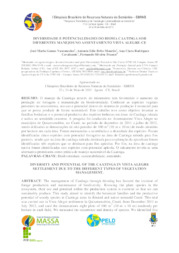Diversidade e potencialidades do bioma caatinga sob diferentes manejos no assentamento Vista Alegre-CE.
Diversidade e potencialidades do bioma caatinga sob diferentes manejos no assentamento Vista Alegre-CE.
Author(s): VASCONCELOS, J. M. G.; MOURÃO, A. E. B.; CAVALCANTE, A. C. R.; FRANCO, F. S.
Summary: Resumo: O manejo da Caatinga através do raleamento tem favorecido o aumento da produção de forragem e manutenção da biodiversidade. Conhecer as espécies vegetais presentes no ecossistema, seu uso e potencial dentro do sistema de produção é essencial para que se possa produzir de forma sustentável. Este trabalho teve como objetivo levantar as famílias botânicas e o potencial produtivo das espécies lenhosas em áreas de Caatinga raleada e nativa no semiárido cearense. A pesquisa foi conduzida no Assentamento Vista Alegre no município de Quixeramobim, no Ceará, no período de dezembro de 2011 a julho de 2012, sendo utilizadas as demarcações de oito parcelas de 100 m2 (10 m x 10 m) de modo aleatório por hectare em cada área. Foram mensuradas a ocorrência e a densidade das espécies. Foram identificadas cinco espécies com potencial forrageiro na área de Caatinga raleada para fins pastoris, sendo que na área de caatinga raleada destinada para exploração da apicultura foram identificadas três espécies que se destinam para fins apícolas. Por fim, na área de caatinga nativa foram identificadas sete espécies com potencial apícola. O raleamento revela-se uma alternativa promissora como prática de manejo sustentável da Caatinga. [Diversity and potential of the caatinga in Vista Alegre settlement due to the different types of vegetation management]. Abstract: The management of Caatinga through thinning has favored the increase offorage production and maintenance of biodiversity. Knowing the plant species in the ecosystem, their use and potential within the production system is essential so that we can sustainably produce. This study aimed to identify the botanical families and the productive potential of woody species in Caatinga areas in thinned and native semiarid Ceará. This trial was carried out in Vista Alegre settlement in Quixeramobim, Ceará, from December 2011 to July 2012, and used the demarcations eight plots of 100 m2 (10 m x 10 m) randomly per hectare in each field. We measured the occurrence and density of species. We identified five species with forage potential in the area of Caatinga thinned for pastoral purposes, and in the area of thinned Caatinga intended for beekeeping exploration identified three species that are intended for purposes bee. Finally, in the area of native Caatinga species identified seven potential bee keeping. The thinning is revealed as a promising practice of sustainable management of the Caatinga
Publication year: 2013
Types of publication: Paper in annals and proceedings
Unit: Embrapa Goats & Sheep
Observation
Some of Embrapa's publications are published as ePub files. To read them, use or download one of the following free software options to your computer or mobile device. Android: Google Play Books; IOS: iBooks; Windows and Linux: Calibre.
Access other publications
Access the Agricultural Research Database (BDPA) to consult Embrapa's full library collection and records.
Visit Embrapa Bookstore to purchase books and other publications sold by Embrapa.

